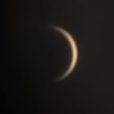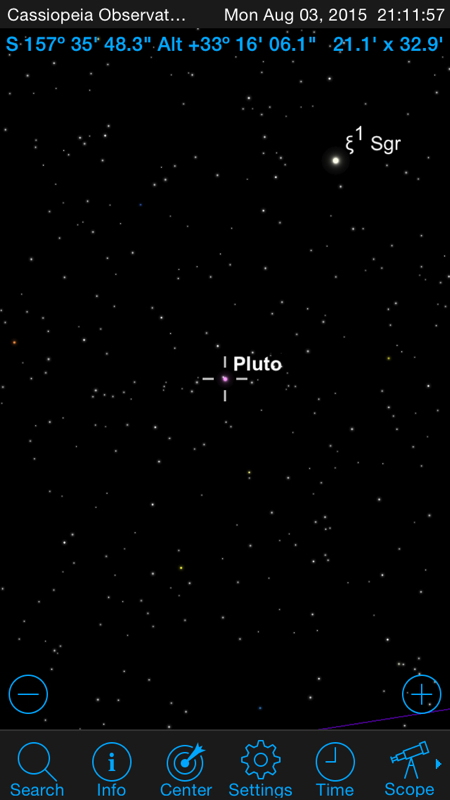Venus, Critter Visitor, Saturn, iPhone Constellations,
iPhone Pluto?, Neighbor Star, Ceres, Moon
Posted: 4 August 2015
|
Open: Monday, 4 August 2015, 1814 MST Temperature: 108°F |
Session: 853 Conditions: Mostly clear, breezy |
Upon opening the observatory I slewed to Venus and then mounted the iPhone 5s for afocal imaging using the MX-1 Afocal Adapter. This is a stack of 1742 slo-mo (120 fps) video frames, 154X:

I then did a Periscope Livestreaming session for 11m25s showing the thin crescent Venus to several viewers. This is how Venus appeared at 154X, zoomed, and using a Variable Polarizing Filter to reduce the brightness of Venus. The app still somewhat overexposed the planet. Click the image to view a few seconds of the live session.

Click or tap on image for video
1850 MST: after ending the Livestream I viewed Venus, 83X. It was really beginning to "break up" now due to its low altitude in the sky and atmospheric distortion. 1852 MST: viewed Jupiter, 83X, faintly visible. The equatorial belts were faintly visible. 1900 MST: viewed Saturn, 83X. Pretty view against a blue sky. Saturn, high in the southern sky, was much easier to see than Jupiter, which was low in the western sky. 1912 MST: viewed Saturn, 166X. Cassini Division was nicely visible.
I had a visitor:

1924 MST: sunset. 1930 MST: the view of Saturn was now excellent at 166X. Began preparing to image Saturn with the D7200 DSLR. Did a focus test image on the star Antares using the Bahtinov Mask. This is a stack of 1845 video frames, prime focus + 2X PowerMate, 1.3X crop factor, 60 fps, 1/60sec, ISO 2500:

2000 MST: removed the camera from the 8" LX200-ACF and switched to the Baader 8-24mm Zoom Eyepiece. The planet was an excellent view at 250X (8mm). The moons Titan, Tethys, Rhea, and Dione were visible. Added the TeleVue 2X PowerMate to the zoom eyepiece. The view was nice up to 333X (6mm). Occasionally there were good views at 500X (4mm). Removed the PowerMate. The best view of Saturn was at 250X (8mm). 2019 MST: the seeing was beginning to deteoriate at Saturn so switched back to the 24mm UWA eyepiece.
The sky was beautiful this night, with the Milky Way visible almost horizon-to-horizon. This is a handheld iPhone 5s photo using the NightCap Pro app (Light Boost, Noise Reduction, ISO 8000, 1/2sec) showing the constellations of Sagittarius and Scorpius. A portion of the Milky Way is faintly visible. Saturn is to the right of Scorpius.

2038 MST: slewed to Pluto to prepare to image it (or try to) using the iPhone 5s. I have been trying to get iPhone photos of Pluto on two adjacent nights but the weather has not been cooperative. So I would try again this night once Astronomical Twilight ended. 2053-2107 MST: short break. When I returned to the observatory I powered on the GC Wi-Fi Adapter and used SkySafari Pro on the iPhone to GOTO Pluto. This is a screen capture showing Pluto in SkySafari Pro:

And this is a NightCap Pro image (Long Exposure, Light Boost, ISO 8000, 1/2sec, 1 minute exposure), afocal 77X. Pluto should be near the center of the image, which is at a similar orientation and scale to the screen capture.

Hopefully I'll be able to get a confirming image the next night.
2124 MST: slewed to the star HD219134 in the constellation of Cassiopeia using SkySafari Pro. The star is 21 Lightyears distant and was recently discovered to have a planetary system. Viewed the star at 83X and 166X. 2138 MST: eastern sky beginning to brighten from rising waning gibbous Moon. This is a screen capture showing HD219134 (HR 8832) in SkySafari Pro:

Mounted the D7200 DSLR at prime focus + 2X PowerMate. Did a focus test on the star Shedir using the Bahtinov Mask. Returned to HD219134 for this 10 second, ISO 1600, exposure:

After imaging our neighboring star HD219134 I went to the asteroid (Dwarf Planet, if you prefer) Ceres. Ceres was at opposition on 25 July but cloudy skies kept me from imaging it until this night. Began waiting for it to get higher. 2230 MST: after doing a focus test with the Mask on the star Antares, I began imaging Ceres at prime focus + 2X PowerMate. I took an exposure every 15 minutes between 2230 MST and 2330 MST, 10 seconds, ISO 3200. This is the first exposure showing Ceres:

I combined the five images taken at 15 minute intervals for this animation showing the movement of Ceres in one hour:

2330 MST: removed the PowerMate and slewed to the Moon. This is a prime focus image, 1/250sec, ISO 400:

I then removed the camera and did some lunar observing at 83X and 166X. Lovely views, especially along the terminator.
|
Close: Monday, 4 August 2015, 2356 MST Temperature: 79°F |
Session Length: 05h 42m Conditions: Clear |
Reminder: I have reviewed many of the accessories I discuss on these Reports. See the Reviews page to see which accessories I've reviewed.
Comments are welcome using Email. If you are on Twitter you can use the button below to tweet this report to your followers. Thanks.
Cassiopeia Observatory Home Page
Copyright ©2015 Michael L. Weasner / mweasner@me.com
URL = http://www.weasner.com/co/Reports/2015/08/04/index.html
